India’s internal security problems are a manifestation of internal weaknesses and external attempts at waging a proxy war. Inadequate socio-economic development, apathy towards the genuine grievances of the people, political brinkmanship amongst other reasons, has created internal contradictions, which have led to decades of internal strife.
Similarly, a number of internal security challenges faced today are fueled and controlled from Pakistan. The presence of hostile neighbours allows the internal conlicts to get external support, which includes money, arms and sanctuaries. The vested interests exploit these conditions to pursue their own schema.
Given the large population, diversity of groups and identities and shrinking share of resources, conlicts are bound to rise in the society. When the democratic institutions and the state structure fails to fully resolve these conlicts in a peaceful manner, violence erupts.
The hostile external forces, taking advantage of this situation through subversive propaganda, further highlight these conlicts. They give material and political support to worsen this sense of grievance to such an extent that a small minority are willing to become tools in their hands to undermine the stability and security of the nation.
According to some experts, India does not face an external threat in the conventional sense, but only internal security threats from external sources. These external sources, consist of both state and non-state actors, combined with those anti-state forces within India, have made the situation more intricate. All over the world, few countries are placed in an unfavourable, troubled and uncertain security environment as India is. External sources of threats to India’s internal security spring from almost all countries of its neighbourhood.
State and Non-State Actors
- At the International level, there are many players engaged in international Politics. The two types of actors involved in international relations include State and non-state actors. State actors represent a government while non-state actors do not. However, they have impact on the state actors.
- State actors are sovereign countries like China, Pakistan, Bangladesh, etc. They are also called as the nation-state while the non-state actors include multinational organisations, international non-government organizations, terrorists, transnational organised crime, etc. While state actors are state oriented, non-state actors are organization oriented.
- The difference between the two is converging as many times, non state actors are state sponsored. For example: Pakistan using Lashkar-e-Taiba and Jaish-e-Mohammed against India.
Threats from External State Actors
Though influence from other countries like Bangladesh, Afghanistan and Nepal cannot be ignored China and Pakistan are the two major external state threats to the internal security of India. Moreover, India has fought a number of wars with Pakistan and one war with China.
Threats from China
The global political architecture is seeing a shift in terms of power from West towards East and the two most populous nations: China and India are both trying to assert themselves. According to United Nations Intelligence council report titled ‘Mapping the Global Future’ by 2020, international community is going to confront the economic, political and military dimensions of the rise of China and India. Officially, the relations between the two countries are known as ‘Strategic and Cooperative Partnership for Peace and Prosperity’.
Both the nations have several similar attributes and problems like conflict with neighbours, economic divide, huge population etc. But there are also major irritants to the relation like Border disputes, river water disputes, Dalai Lama and Tibet issue, String of Pearls issue, Indian Ocean, South China Sea disputes etc.
Border Standoffs
India and China share about 3488 km long border which is yet to be completely resolved. The unresolved territorial disputes lead to frequent incursions and intrusions. The India-China border is divided into three sectors:
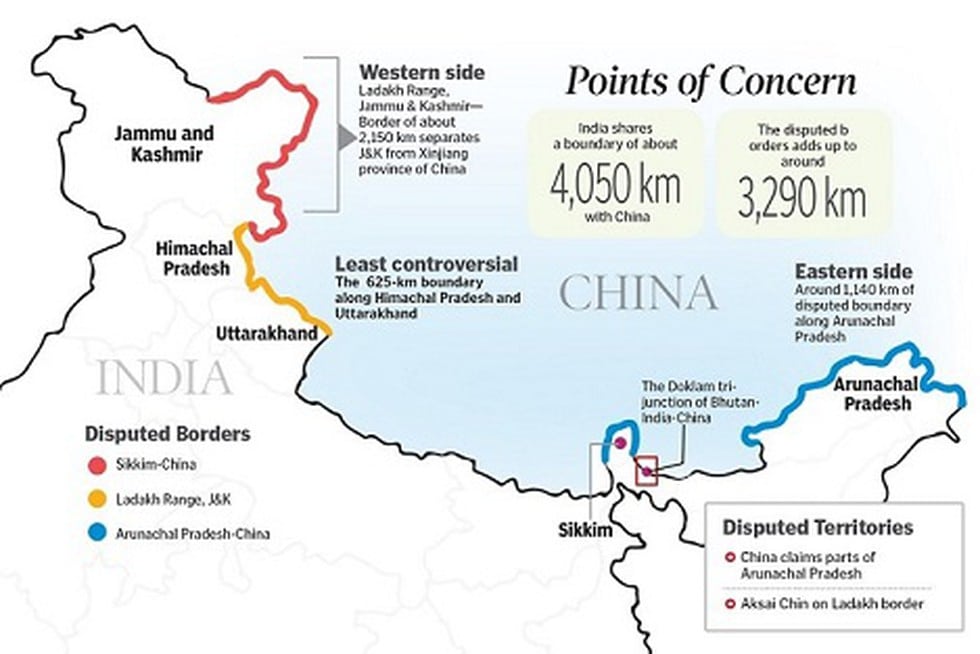
1. Western Sector:
- It is about 1597 km long and is between Jammu and Kashmir and Xinjiang province of China and the line that separates the Indianadministered areas of Jammu and Kashmir from Aksai Chin is known as the Line of Actual Control (LAC). Two borders were proposed during the time of British Raj, one based on Johnson’s Line and the other based on McDonald Line. Johnson’s line shows Aksai Chin under the Indian control whereas the McDonald Line places Aksai Chin under Chinese control. China and India went to war in 1962 over the disputed territory of Aksai Chin as India claims it to be part of Kashmir whereas China claims it to be part of Xinjiang.
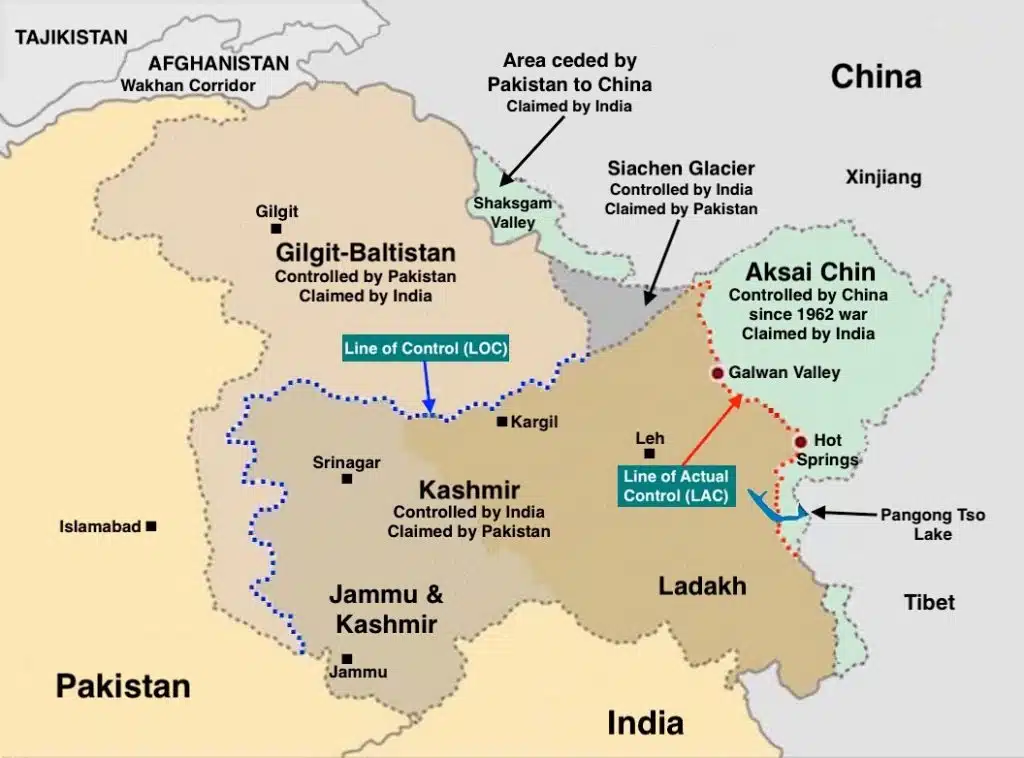
2. Middle Sector:
- It is about 545 km long which runs along the watershed from Ladakh to Nepal and is the least controversial among the three sectors. The Indian states of Himachal Pradesh and Uttarakhand touches the border with Tibet.
3. Eastern Sector:
- It is 1346 km long boundary historically known as McMahon Line. It runs from the eastern limit of Bhutan to a point near the Talupass which is at the trijunction of India, Tibet and Myanmar. China does not accept the McMahon Line as it was agreed by a Tibetan representative under the 1914 Convention in Shimla. China claims the whole of Arunachal Pradesh around 85,000 sq.km, as its territory.
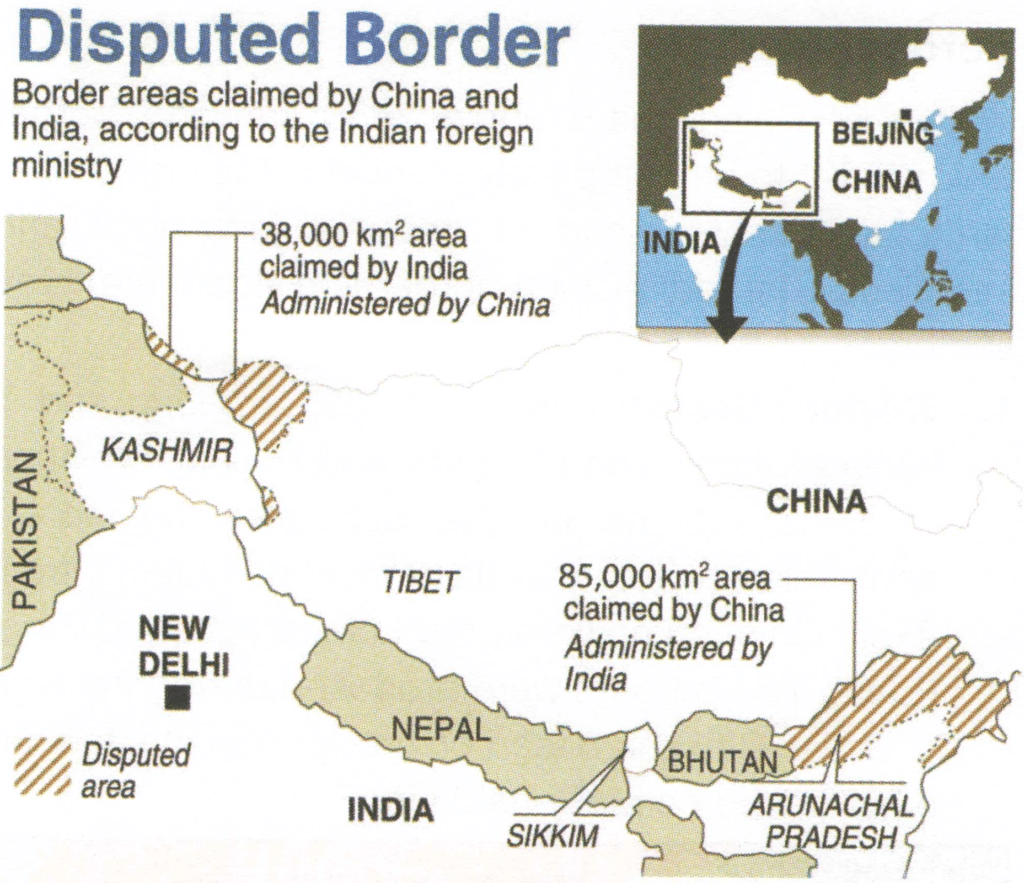
Timeline of Standoffs between India and China
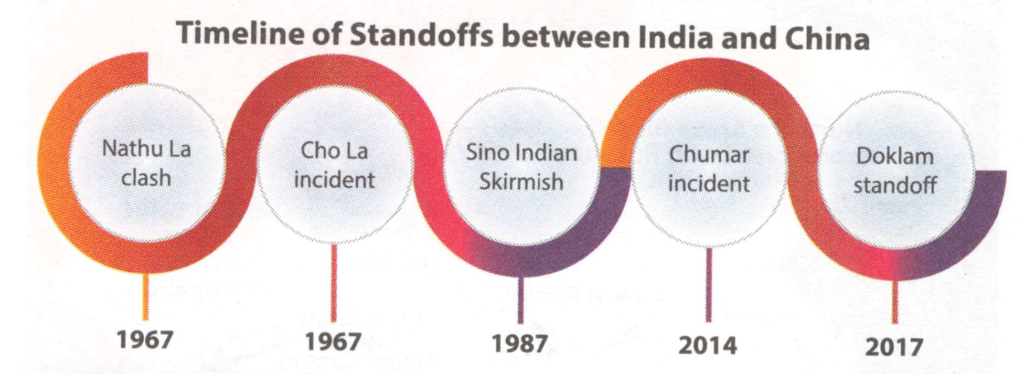
- Nathu La Clash (1967): In 1967, Chinese and Indian forces clashed at Nathu La after months of accusations from both sides about incursion and territorial intrusions.
- Cho La Incident (1967): In 1967, Indian and Chinese forces clashed again the same year of Nathu La incident.
- Sino-lndian Skirmish (1987): In 1987, Indian military movements in Arunachal Pradesh’s Tawang were seen as provocation by the Chinese which led to predictions of war.
- Chumar Incident (2014): In 2014, more than 200 People Liberation Army soldiers entered what India considered to be its own territory and used cranes and bulldozers to build a 1.2 mile road. This was important as it happened during the visit of Chinese president Xi Jinping to India.
- Doklam Standoff (2017): It was a 73 days stand-off between Indian and Chinese troops at Doklam, a trijunction where borders of India, Bhutan and China meet. The issue flared up when the Chinese were trying to construct a road in the area, and Indian troops, in aid of their Bhutanese counterparts, objected to it, resulting in the stand-off.
Doklam Standoff
- Doklam is a plateau at the trijunction of India, China, and Bhutan. It is a 269 sq. km patch of Bhutan’s territory located in the Chumbi valley. Doklam is a bone of contention between China and Bhutan. There are 3 border issues between China and Bhutan Jakarlung and Pasamlung in the northern region are the other two issue. China in 1990s is understood to have proposed to Bhutan a ‘package deal’ under which China is ready to give concessions in other 2 sectors in return of concession in Doklam as it has strategic importance.
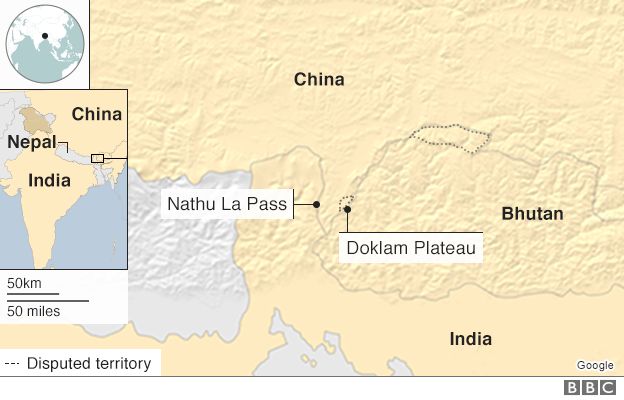
Issue
- China’s People Liberation Army soldiers started building a permanent road in the disputed area and even brushed aside the objection from Bhutan. India sent troops to protect Bhutan’s territorial interest under the friendship treaty.
Significance for India
- Doklam is strategically located close to the Siliguri Corridor, which connects mainland India with its northeastern region. The corridor, also called Chicken’s Neck, is a vulnerable point for India. Control of Doklam by China would cut India into two because of strategic importance of Chumbi valley, which is located just above India’s chicken neck that connects India’s North East to the rest of the country. It would thus give military advantage to China over India.
Chinese Objective
- Allowing this road will allow China ‘Land Pearl’ to surround India. This is seen as part of 5 finger policy of Mao Zedong.
- 5 Finger Policy
- Tibet as palm, China will attack India from 5 places:
- Ladakh
- Nepal
- Sikkim
- Bhutan
- Arunachal Pradesh
- Tibet as palm, China will attack India from 5 places:
- It is also seen as an attempt to create political confusion in Bhutan as it was just before the general election in Bhutan, thus trying to create troubles in Bhutan for a friendly government. It shows China trying to influence Bhutan like it did in Nepal.
- It may be considered to be part of ‘three warfares strategy’ of China.
- It was also seen as part of China’s Standard operating procedure where China encroaches upon the target country’s land or maritime territory and starts building heavy infrastructure, then claims the territory based on ‘historical grounds’, next plays the victim card and then starts issuing threats to withdraw and succumb to demands.
The whole issue led to standoff between the two countries which went on for more than 10 weeks and was being feared to turn into a full-fledged war. But the issue got resolved diplomatically and security expert believe that such kinds of standoffs are only going to rise in future. India needs to be well prepared to be able to tackle any such threat in future.
Infrastructure Development in Tibet
After the 1962 war, China applied its energy and resources to create a world class, state of the art, multi-dimensional and multi-modal infrastructure in the Tibet autonomous region. It has built vast road and rail network thus improving the connectivity in the region. The infrastructure development has not only helped China to integrate Tibet but also enhanced its military might along the Sino-lndia borders. Infrastructure Development near Line of Actual Control
- It allows better border management on the China’s side of the border. Also, PLA troops positioned on the road heads have given them the ability for quick reaction/action, given the easy mobility.
- The road connectivity facilitates China’s claim towards the disputed territories. It is bringing the settlement closer to the Line of Actual Control and thus establishing its territorial claims.
- The infrastructure development gives China the capability to sustain 30-32 divisions including 5-6 rapid reaction forces which gives them flexibility in operations.
- These development reduces overall military expenditure to maintain border due to easing of the logistical difficulties faced by the PLA.
Options for India
- India needs to improve its infrastructure in the border and its need to be done on a war footing. Not only to raise protest but also to save its economic and security interests, India needs to build deterrence and dissuasion capabilities by enhancing the capacity of the forces. In addition to increasing the number of personnel, the need is to modernize the whole force.
China-Pakistan Economic Corridor (CPEC)
China-Pakistan Economic Corridor (CPEC) is a collection of infrastructure projects that are currently under construction throughout Pakistan. It would help in deepening economic ties between China and Pakistan. CPEC intends to modernize Pakistan’s economy by the construction of modern transport networks, several energy projects and through creation of Special Economic Zones (SEZs). It is a route consisting of highways, railways and pipelines that will connect Gwadar port to Kashgar in the Xinjiang province of China. The CPEC is part of the Belt and road initiative that seek to deepen Mainland China’s economic cooperation with a number of Asian and European countries.
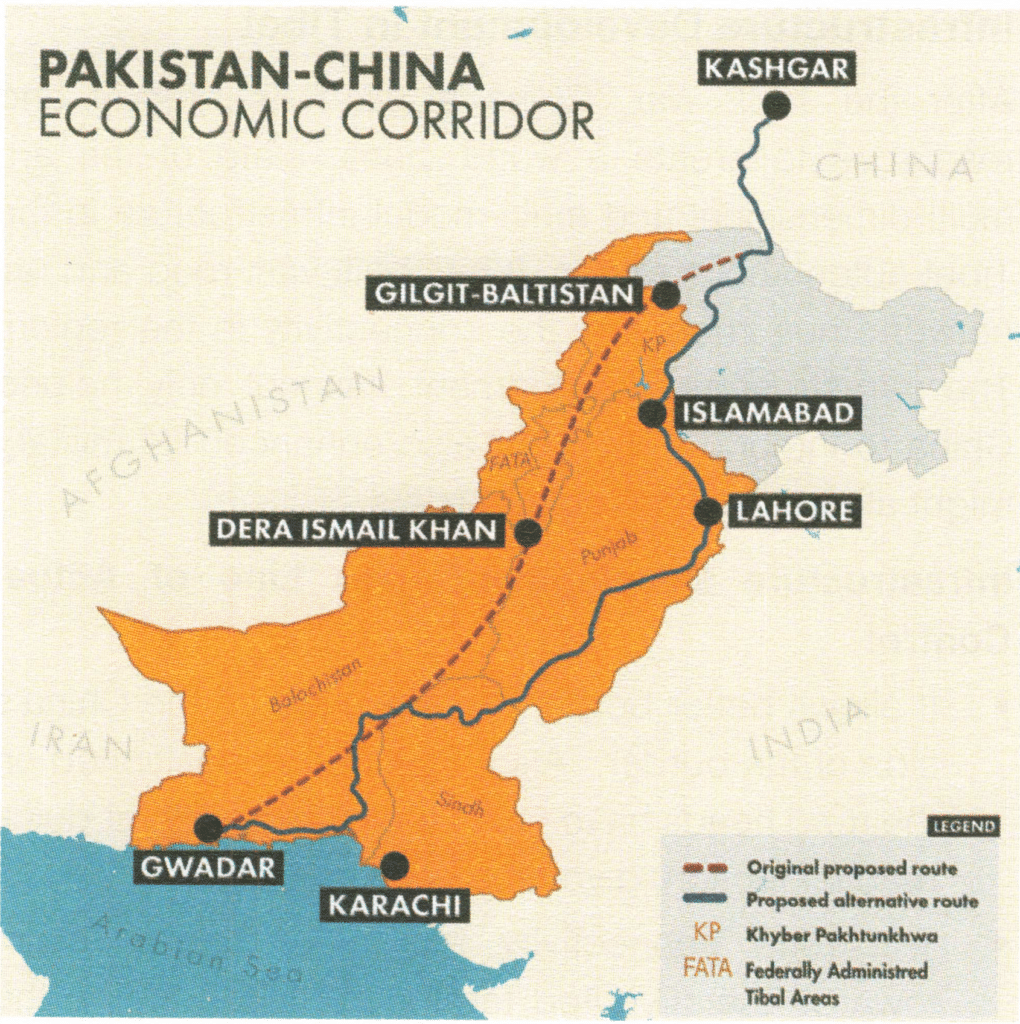
India’s Concern
- CPEC passes through the disputed Pakistan occupied Kashmir thus challenging India’s sovereignty and its claim over the area. It would serve the purpose of granting legitimacy to Pakistan’s control over the region.
- From security point of view, Gwadar port is seen as a part of ‘String of Pearls’, through which China is trying to surround India from all the four sides. It would give China a strong foothold in the western Indian Ocean with the Gwadar port, located near the strategic Strait of Hormuz, where Chinese warships and submarines recently surfaced.
- India sources more than 60% of its oil supplies from the middle east which is going to increase in the future. The supply passes through Strait of Hormuz and access to Gwadar port gives China a greater potential to control the maritime trade in this part of the world. This could act as the choking point for India in future. Also, from trade point of view, it could obstruct India’s connectivity to Central Asia and Middle East.
Options for India
- To counter the influence of Chinese presence in Gwadar port, India is developing the Chabahar port and has already signed an agreement with Iran. India is developing partnerships with different countries to be able to counter the influence of CPEC.
- Agreements on International North-South Transport Corridor, Asia-Africa growth corridor, relations with other oceanic countries in order to counter the economic aspect of the project.
- India needs to improve its domestic infrastructure, improving border management and the port
infrastructure in the country.
- India could highlight its concerns through diplomatic initiatives but it might be of little gain as has been seen in the recent past. It needs to improve its own infrastructure and defense capabilities along with improving relations with other countries to be able to counter the China-Pakistan Economic corridor.
Belt and Road Initiative
- The Belt and Road Initiative refers to the Silk Road Economic Belt and 21st Century Maritime Silk Road. It is a significant development strategy launched by the Chinese government with the intention of promoting economic co-operation among countries along the proposed Belt and Road routes. The Initiative has been designed to ensure free-flow of economic factors and the efficient allocation of resources. It is also intended to further market integration and create a regional economic co-operation framework for benefit to all.
- It would link the South China Sea, South Pacific Ocean, Indian Ocean, Persian Gulf, Mediterranean Sea and the Eastern Coast of Africa at various points. The thrust is on reviving the ancient maritime route and inherits the friendly philosophy from the old silk route to build a new one. It would build a network of port cities along the Silk route and link it with the economic hinterland in China.
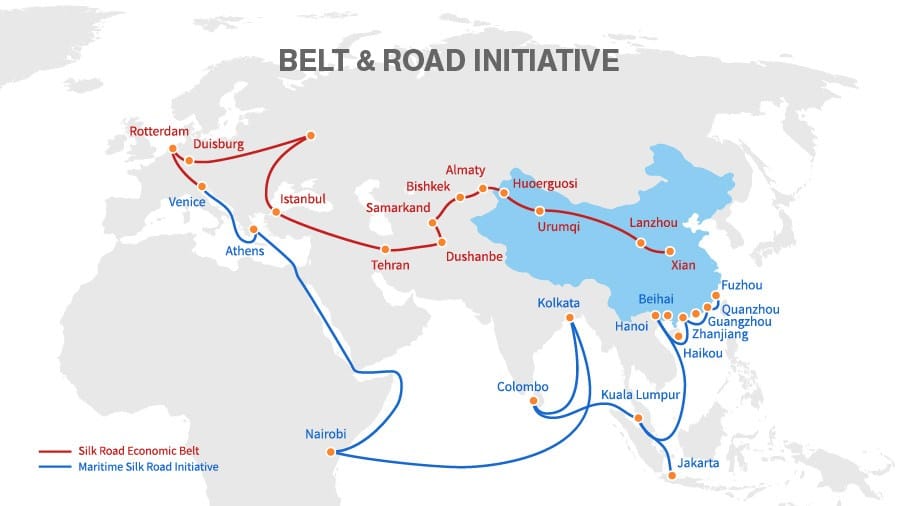
Advantages for China
- Economic
- It will open up and create new markets for Chinese goods and technology at a time when the economy is slowing.
- It would help China in exporting high quality technological and engineering standards.
- Will help China promote itself as the new global champion of free trade.
- OBOR will help China to assert its regional leadership through a vast program of economic integration.
- It will encourage regional development in China, especially less developed regions through more opportunities to export.
- It will help in upgrading Chinese industry while exporting Chinese standards to the world.
- Geostrategic
- The initiative would help China in achieving strategic objective and transform it into a naval super power .
- OBOR will help in maintaining peace and stability in China’s neighbourhood through regional economic integration by speeding up the process of building infrastructure and connectivity
- It is also seen as an answer to Trans-Atlantic and Trans-Pacific partnership along with US policy of pivot to the Asia-Pacific region. Thus, for China, OBOR will also act as a strategic tool to counter the US pivot to Asia.
- India’s Reservation to OBOR
- India has clearly shown its reservation to maritime silk route and the overall Belt and Road Initiative. It had not even sent a representative to the last conference on Belt and Road Initiative. The reasons and implication of the projects are:
- China Pakistan economic corridor which passes through the disputed territory of Kashmir challenges India’s sovereignty and territorial integrity. Though improved connectivity and enhanced cooperation has multiple benefits to India, India’s sovereignty and security issues outweighs other issues.
- The opacity of the whole project is highly questionable . Though the Belt and Road Initiative is being projected as exclusively commercial but the details are still not out which makes India apprehensive about China’s military intentions . Despite maintaining that the focus is on infrastructure development but there is little doubt that infrastructure connectivity would increase China’s strategic influence across the maritime boundaries.
- Expansion of String of Pearls: India’s strategic community sees OBOR as the extension of the “string of pearls”. They consider it as a systematic and deceptive strategy loaded with covert ambitions hidden under the cloak of economic development and shared prosperity. This would not only reduce India’s influence over Indian Ocean but Maritime Silk route is going to further affect its strategic influence in the region.
- India also had its economic concerns as no one is certain about the way project will pan out. Also, huge investment by China could affect the economy of the region.
- India has clearly shown its reservation to maritime silk route and the overall Belt and Road Initiative. It had not even sent a representative to the last conference on Belt and Road Initiative. The reasons and implication of the projects are:
- Response and Options for India
- The Indian strategic community believes that the Maritime Silk Route can potentially help China to consolidate its maritime strategy of access and basing in the Indian Ocean. Consequently, to counter the Chinese influence, India has taken a few steps. Some of them are as under:
- India has launched ‘Project Mausam’ which aims to reconnect nations along the ancient spice route in the Indian ocean through increased cultural exchanges, commercial ties and is focusing upon improving the connectivity in the region.
- India, along with Japan and African nations, is developing Asia-Africa Growth Corridor with an objective of enhancing trade growth and improving connectivity between Asia and Africa. In addition to greater people to people contact, it will strive to develop institutional, industrial and transport infrastructure in the Asia- Africa region.
- At the same time, India’s focus is on improving its own infrastructural facilities, strengthening its defense capabilities and improving trade relations with the other countries.
- The Indian strategic community believes that the Maritime Silk Route can potentially help China to consolidate its maritime strategy of access and basing in the Indian Ocean. Consequently, to counter the Chinese influence, India has taken a few steps. Some of them are as under:
Way Ahead
- Maritime Silk Route has appeared as a new threat to the security and the strategic advantage India has in Indian Ocean. India soon needs to develop an alternative if it is not going to join it in future. Silent opposition of the initiative by India is not going to help for long.
Asia-Africa Growth Corridor
- Aim: To create a free and open Indo-Pacific region by rediscovering ancient sea routes and creating new sea corridor connecting Africa with South and South East Asia.
- Difference from Belt and Road Initiative: It is an initiative borne out of consultative process unlike the government funded model of Belt and Road initiative. In AAGC, apart from trade an economic relations, more emphasis is capabilities development.
- Significance: The AAGC offers a benevolent alternative to the Belt and Road Initiative that holds significant potential for regional connectivity on a state-to-state level. Major railroad projects linking Delhi to Hanoi indicate an old interest within Southeast Asia to diversify trade and ties.
- Given Japan’s experience with mass projects and expertise in developing cutting edge train networks, such as the Shinkansen, there is room for cooperation. Investing in strategic infrastructure projects such as ports, rails, and telecommunications would find receptive customers in countries seeking to minimise their dependence on individual trading partners.
String of Pearls
String of pearls refers to a network of Chinese military and commercial facilities extending from China mainland to Port of Sudan. The term was coined to describe China’s increasing forays into the Indian Ocean, thus establishing its nodes of influence. Here, pearl represent each node that is China’s stakes in the country’s ports like Sittwe in Myanmar, Chittangong in Bangladesh, Hambantota in Srilanka, Gwadar in Pakistan and others. From India’s point of view, it is like encirling India from all sides which would be a security nightmare for the country. It would also affect India’s strategic advantage in the Indian Ocean region.
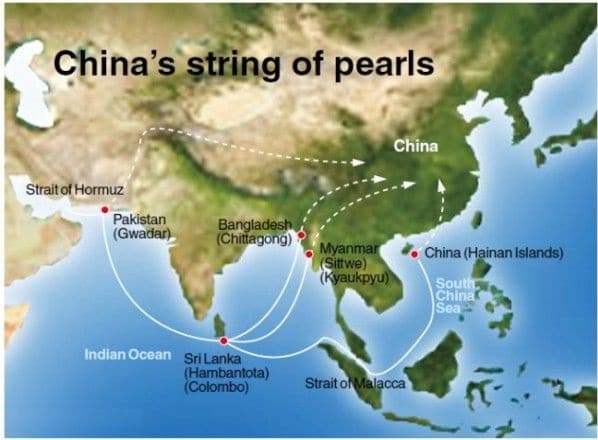
India’s Response
- India has increased the activity in South China Sea and is developing close relations with neighbouring countries of China like Vietnam. India is also involved in a number of oil and natural gas explorations in the South China Sea.
- India knows that it may not be able to contain China alone so it has developed close relations with countries like Japan, Australia, and USA. As a part of extended Malabar exercise, naval exercises in Bay of Bengal are being held between India, Japan and USA. It plans to include Australia as well. India is also developing close relationship with the Indian Ocean rim countries to counter the Chinese influence.
- India and Japan are partnering to develop an AsiaAfrica growth corridor.
- India is focusing upon boosting its civil maritime infrastructure, improving its capabilities to take up maritime activities in other countries and under Sagarmala project, it is developing the port.
Conclusion
- India needs to undertake certain preparatory measures to effectively control its maritime surroundings and curb Chinese influence among certain key oceanic ‘swing’ states as it could reduce India’s tactical advantage in the sea given its geographical location.
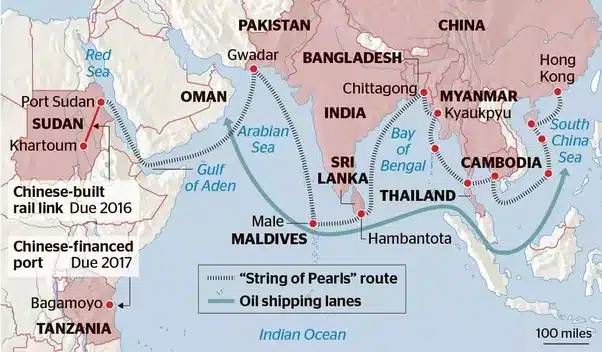
Nexus with Pakistan
China-Pakistan describe their relationship as ‘higher than mountains, deeper than oceans, sweeter than honey’ and now with China Pakistan Economic corridor, they might add it to ‘Stronger than steel’. This ‘all weather’ relationship is a layered story of several highs and lows but all through, India had been the dominant theme. Andrew Small, in his book, “The China-Pakistan Axis”, writes down India is the strategic glue that holds the China-Pakistan relationship together.
Background
It was only after India’s defeat in the war with China (1962) that the Pakistan-China relationship really took off. Under Sino-Pakistan Boundary agreement of 1963, Pakistan illegally ceded 5180 sq. kms in Pakistan Occupied Kashmir to China. It was the first brick in the relationship between China and Pakistan. China identified Pakistan as a country to contain India which could be seen in its tacit support to Pakistan during the India-Pakistan war of 1965 and 1971.
Possible Threat
- China, in 2016, acknowledged assistance to Pakistan in building 6 nuclear reactors which confirmed its role in the development of Pakistan’s nuclear bomb, which is acting as a permanent threat to India.
- China opposed India’s membership in Nuclear Suppliers Group and by using Pakistan as a front. China stated if India could be allowed, then Pakistan should also be allowed membership to the group.
- China even opposed India’s efforts to list Masood Azhar as a Global Terrorist by the UN thus shielding the chief of Pakistan terrorist outfit Jaishe-Mohammed from getting listed. It saved Pakistan from an embarrassment and increased the threat for India.
- China-Pakistan Economic corridor under which Pakistan is giving China access to Gwadar port and thus increasing the Chinese presence could be a threat to India’s security. Also, the corridor passing through Pakistan occupied Kashmir which gives a tacit approval to the disputed territory as Pakistan’s territory, therefore challenging India’s sovereignty.
- China has provided all out military assistance to Pakistan on the three critical fronts, i.e. export of defense equipment, assistance in building its indigenous defense capability and its nuclear arsenal. This military assistance has acted as a continued threat to India’s security.
Thus, China-Pakistan Axis is acting as a threat to the sovereignty and security of the country. Moreover, terrorism emanating from it is a geopolitical challenge for the country.
Way Ahead
- China is export oriented country and India is a big market for it in present as well as near future. Thus, improving trade ties, reducing trade deficit would help in improving the overall relationship with China. India needs to improve its relationship with its own neighbours and those of China’s neighbour especially Japan. Also, it could forge relationship with countries like Japan, Australia in developing infrastructure in neighbouring countries as seen in the case of Bangladesh. India needs to focus on indigenization of defense products and thus improving its defense capability as China as well as Pakistan cannot be trusted.
Conclusion
- China’s continued support to Pakistan will obstruct India’s efforts to fight terror and would not allow the containment of radicalism. Thus, India needs to build up its economic and security capabilities to be able to close the power gap with China.
Threats from Pakistan
Terrorist Attacks
- Pakistan is one of the state which uses non-state players to fulfill the state objectives. This has been Pakistan’s policy since 1947.
- Pakistan supports various anti-Indian and terrorist groups against India like Jaishe-Mohammad, Kashmir separatist organizations like JKLF, Hizb-ul-Mujahideen, etc. Officially, Pakistan denies it and claims that it provides only moral support without any economic or military support.
- However, according to a report by a group of eminent South Asian Experts , Pakistan military continues to support the terrorist groups that attack India to keep it ‘offbalance’ and draws international mediation into dispute with India over Pakistan.
Support for Terrorist Groups
It is well reported that Pakistan forces, especially ISI (Inter Services Intelligence) not only provides moral
but also economic and military support. They provide training, extensive funding, intelligence reports and weapons. This could be further elaborated as follows:
- Terrorist Financing along with the fake currency notes, hawala transactions, etc. are most important components of Pakistan as a state sponsor. It is also a common man view that Pakistan uses these groups against India.
- It is perceived that Pakistan provides training grounds for terrorist groups inside Pakistan. For example, during the surgical strikes in September 2016 by India, terrorist training grounds were targeted by the security forces.
- It has been established that Pakistan provides help with sophisticated technological products and intelligence reports as found during the 26/11 Mumbai attack.
- Financial Action Task Force has placed Pakistan on the grey list for failing to curb terror financing on its soil. The decision was taken at the FATF plenary session in Paris. FATF also laid out 10-point action plan for Pakistan for compliance with its guidelines. If Pakistan fails in implementing the elaborate action plan, it may result in being included in FAFT’s Black List in 2019. This will be second time Pakistan has been grey listed by FATF, for first time it was placed in the list for three years from 2012 to 2015.
Options for India
India opted for a diplomatic route to isolate Pakistan from various international bodies. India used its relationship with other countries to issue a stern message against terrorism especially state sponsored terrorism. At the BRICS summit, East Asia Summit, the UN and at several other platforms, India came up with joint statements, and issued stern warnings against terrorism. India can thwart the Pakistan challenge by:
- Upgrading the defense infrastructure and improving the intelligence coordination, which was seen as a failure in Uri as well as in Pathankot attack. India has to stop infiltration of terrorists by improving border management.
- Leveraging socio-economic development and soft power at the global and regional level to isolate Pakistan.
- Putting a check over finances of terrorist organizations by eliminating counterfeit currency, drug money etc., by improving the monitoring system and increasing the effectiveness of Financial Intelligence Units.
- Conducting surgical attacks on terror sponsors so as to increase the cost of terrorism and instill fear in the minds of sponsors.
- By engaging with the Pakistan’s civilian as well as military leadership because as long as Pakistan’s military remains anti-Indian, the terrorist attacks are going to continue.
- By conducting ‘hot pursuit’ or ‘surgical strikes’ against the terrorist launchpads along the LoC. India has been suffering for more than three decades at the hands of terrorism. India needs to adopt a standard operating procedure to fight against terrorism through the use of technology. Also, India must strive for more cooperation and better coordination between various security agencies. It should put pressure on UN to adopt a comprehensive definition on terrorism so as to be able to take actions against terrorists such as Hafeez Saeed, Masood Azhar, etc., who see Pakistan as a safe haven.
Hot Pursuit
Hot pursuit owes its origin to the law of the seas against vessels that are involved in piracy or smuggling. The coastal country would take action in spite of the principle of freedom of the high seas – the rights of vessels of all nations to navigate freely on the high seas. The rule ensured that the violating ship is unable to escape citing the protection under the right to free navigation on the high seas, which had been designed to protect innocent vessels.
Nations have time and again used the argument of self defence to enter the territory of another country in pursuit of a terrorist, terrorist organisation, criminals or anyone that is threat to the defence of the pursuing country.
On 4th June 2015, an Indian Army convoy was ambushed in Chandel District, Manipur. Twenty Indian soldiers were martyred, in one of the worst militant attacks in North-East India in a decade. In response, the Indian Army sent in Paratrooper Special Forces to trace the attackers along the India Myanmar Border and destroy their militant stronghold, before more terror attacks could follow. It was a classified mission that ’s now known as operation Hot Pursuit.
Surgical Strikes
A surgical strike is essentially a swift and targeted attack on specific target that aims to neutralise them while ensuring minimum collateral damage to the surrounding areas and civilians. Neutralisation of targets with surgical strikes also prevents escalation to a full blown war. Surgical strikes are part of India’s Cold Start doctrine and have proved effective in foiling infiltration bids by terrorist groups across the LoC.
Methods of Surgical Strikes
- These attacks can be carried out via air raids, airdropping special operation teams or a ground operation. All three Indian armed forces have their separate special operation teams for surgical strikes. The details of the surgical strikes have understandably not been revealed by the Indian authorities. As external intelligence is vital to carry out these attacks, these special operation teams work closely with the service intelligence departments, Intelligence Bureau and R&AW hawks.
Importance for India
- Surgical strikes gain importance in India’s case as Pakistan has repeatedly shown its intention to use tactical weapons on Indian Forces, even risking the collateral damage to its own troops, to stop Indian military operations. Therefore, the covert surgical strikes are a powerful weapon for the Indian armed forces to carry out the necessary dirty work while ensuring the status-quo between the opposing armies on the LoC.
Surgical Strikes- Recent Instances
- India has carried out many hot pursuits and surgical strikes in the last few years. All have been undertaken with some understanding with the host country whether they openly agree or not. Because of terror camps in Myanmar, Nepal, Bhutan and Bangladesh, India has carried out strikes against armed groups.
- Pakistan has been violated many times over by the Americans. But in all those cases there was tacit support from the Pakistani side. The operation to assassinate Osama Bin Laden could not have taken place without a secret understanding between the US and a section of senior Pakistani military leadership.
- In September 2016, India carried out ‘Surgical Strikes’ on terrorist launch pads of militants along the line of control in Kashmir to counter terrorism and infiltration. The operation focused on ensuring that these terrorists did not succeed in their design to cause destruction and endanger the lives of our citizens. Moreover, the surgical strike was based on specific intelligence- ‘hot pursuit ’ of terrorists or taking preemptive action against a likely attack is legitimate under international law. It is important to note that the strike was not against the Pakistan but against the terrorists.
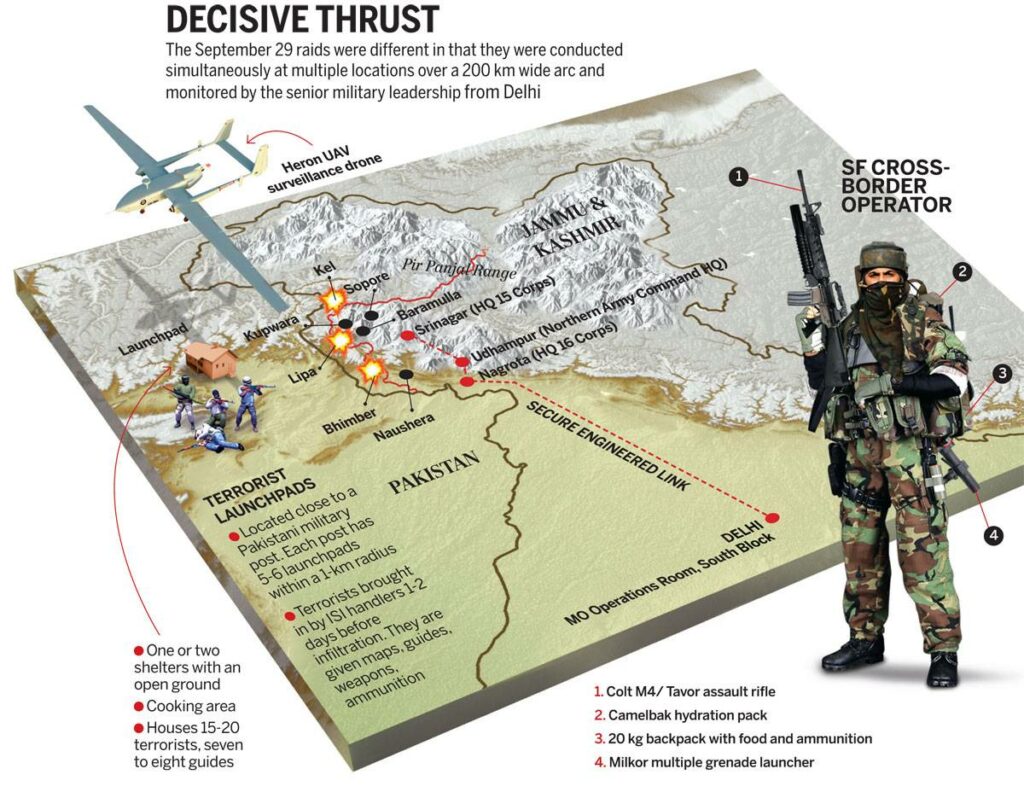
Hot Pursuit- Sign of a Good Relationship?
The ability to go after terrorists and criminals is a sign of a friendly relationship between nations. But with Pakistan, India mostly has had a hostile relationship. It is widely believed that the camps of terror groups exist due to Pakistan government’s patronage. Consequently, hot pursuit near Indo-Pak border needs to be carried out with full readiness as it may escalate into a full-scale war.
Implications of ‘Surgical Strikes’and‘Hot Pursuits’
- Short-Term Implications
- Indian Army’s surgical strikes across the LoC seem to have delivered the right message to Pakistani leadership and terror chiefs living in the country. According to government sources, terror chiefs in Pakistan have been told to maintain a low profile in the wake of Indian army’s operation in Pakistan Occupied Kashmir.
- Arising from India’s attempt to isolate Pakistan diplomatically as a prelude to Indian surgical strikes, and its international aftermath, Pakistan Army’s strategies of state-sponsored terrorism, use of so-called non-state actors and other disruptive actions against India, are under closer global scrutiny and also within Pakistan.
- With the recent surgical strikes, India has stated strongly that it will solve its internal matter itself without needing interventions of world powers.
- The surgical strike intervention shows India’s determination to hold its promise made in 2004 that it would not allow its soil or territory under its control for any terrorist activities against India.
- The sober and controlled action has added heft to India’s six-month old campaign of non-violent compellance to push Pakistan to abandon support to terrorist proxies. This campaign has involved public calls for sanctioning and isolating Islamabad at the G-20 and ASEAN summits, as well as in the US Congress and other high-level meetings.
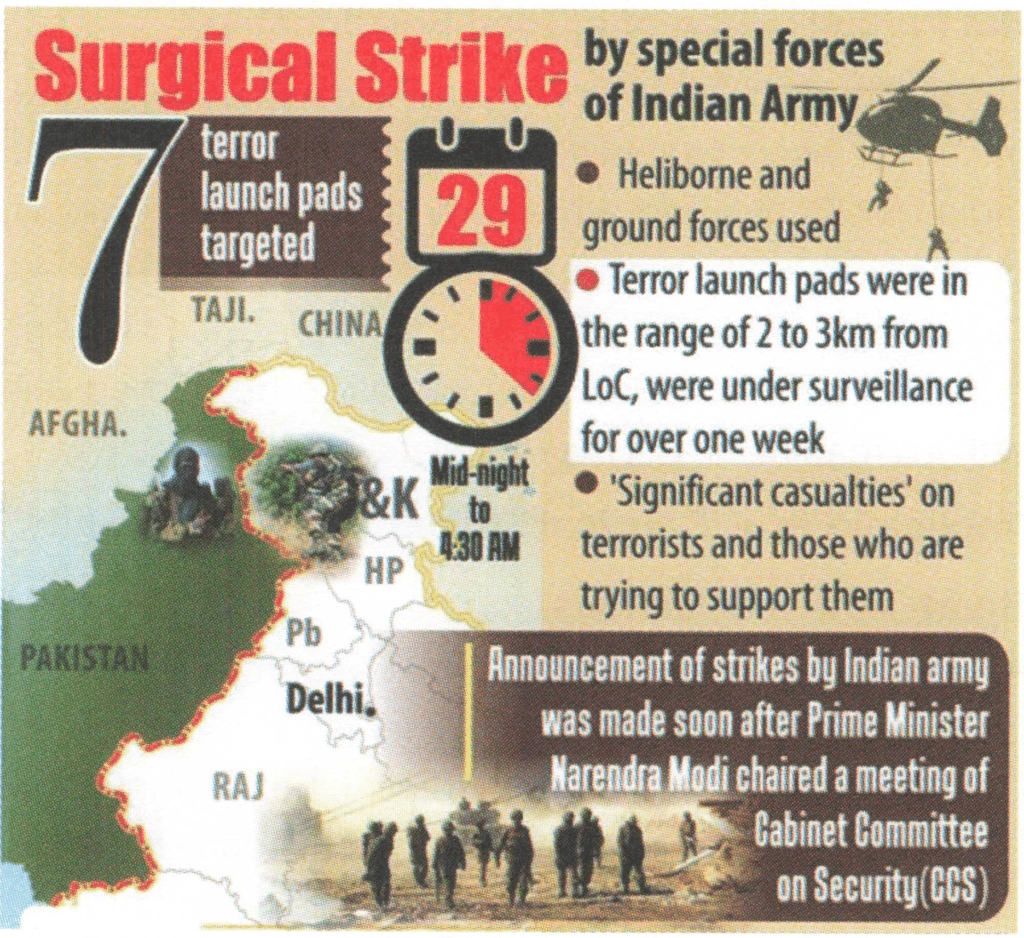

- Longer Term Implications
- It broke the shackles imposed on the military by earlier regimes that they cannot act against Pakistan. Fear of escalation, an all-out war kept them from taking retaliatory action. They couldn’t carry out air strikes. There was always the nuclear question hovering over their heads. This was embedded in the minds of military leaders as well as on ground personnel.
- The surgical strikes created a sense of uncertainity in the minds of the Pakistani military leadership. They now wonder what India’s response would be if they escalate tensions beyond a point. Unlike India’s predictable response in the past wherein if Pakistan killed Indian soldiers, New Delhi would have come out with a statement criticising this, or sent a dossier, or at most open up artillery fire at the border
- There is a danger that the new dynamic in IndiaPakistan relations could lead to the termination of the ceasefire on the LoC. This could happen through a process of escalation of the present situation. Or it could arise from a deliberate Pakistani policy aimed at making things in Jammu and Kashmir hot for India. Bombardment on the LOC would aid Pakistan in stepping up infiltration directly, as well as indirectly, since it would lead to the destruction of the LOC fencing which has played a significant role in reducing infiltration. India has made its point clear that it intends to police the LoC more intensely. For the present, Pakistan has conveniently sidestepped the challenge by denying anything happened.
- It has the potential to create a semi-war or war-like conditions in the region which could potentially be devastating for the global economy.
Perhaps the biggest question before India will be: How far can we allow Pakistan issues to distract us from our focus on economic transformation? The so-called strategic restraint of past governments was aimed at “managing” Pakistan at a low level of violence. In other words, India is not just seeking to manage Pakistan, but to actually transform it from a supporter of terrorists to one which systematically dismantles its decade’s long support for violent Islamist radicals who attacked India and Afghanistan.
Way Ahead
- Despite significant differences between India and Pakistan, consultation process should not be put on back burner. There are other ways like applying unilateral economic sanctions, reduction in trade and putting international pressure but, bilateral dialogue process should never be done away with. Engagement with Pakistan by involving Pakistani administration in the dialogue process is a must.
Cease-fire Violation Across the Border
Cease-fire on the borders had been one of the most tangible and effective military confidence measures between India and Pakistan. It was a Pakistani proposal, which was reciprocated by India with the caveat that it reserved the right to deal with infiltrating terrorists across the border. But in the last few years, there have been violations of the agreement and according to a data compiled by Ministry of Home Affairs, Pakistan has violated the ceasefire along the international border and Line of Control in Jammu and Kashmir more than 720 times in 2017, highest in the last seven years.
Reason for Ceasefire Violations
- The fundamentalist elements within the Pakistan Army who are against the peace process may be indulging in such acts. But Pakistan Army being a professional and cohesive force, the likelihood of this possibility is also low.
- The violation could be a well thought out and planned strategy of the Pakistan establishment. It would be used to deflect pressure and resist any demands for an increase in force levels to undertake any concerted operations against terrorist organizations.
- Many a times, these cease-fire violations are used as a cover given to terrorists who try to infiltrate across the border. As per the relevant statistics, both infiltration and ceasefire violation are on rise.
Threats from External Non-State Actors
Terrorism
Terrorism is a calculated, targeted and indiscriminate use of intimidatory violence to achieve an objective which could be political, social, economic or religious. It is a byproduct of a perverse mind. Presently, many parts of the world is grappling with the scourge of terrorism and its dangerous consequences. It is seeking to destabilize the geo-political order in several parts of the world.
A terrorist provides vent to anger on behalf of a group or a community. The violence is indiscriminate in the sense that it makes no distinction between the state and society and between the security forces and other representatives of the state and civilians of the society who have nothing to do with the state.
Unfortunately, while the world acknowledges the threat of terrorism, there is no consensus even on the definition of terrorism. The UN has adopted numerous resolutions to fight terrorism which shows the global resolve to fight terrorism.
As we still struggle to solve simpler issues like definitions of terrorism, terror groups are becoming deadlier day by day. From traditional form of terrorism, we are now witnessing different forms of terrorism like cyber terrorism, narco-terrorism and bio-terrorism. Modern weapons, technology and communications are being used by terror groups to enhance their lethality and impact.
Threats to India
India has long suffered the violence from extremist attacks based upon separatist and secessionist movements as well as ideological disagreements. The territorial dispute over Jammu and Kashmir is believed to have fueled large scale terrorist attacks such as the bombings of Mumbai sub-urban railway in 2006 as well as a deadly explosion on an India-Pakistan train line in February 2007. Terrorist organizations aim is to create an environment of fear and distrust between groups and communities that differ on ideological background.
Banned Terrorist Organisations in India
Jammu & Kashmir
- Lashkar-e-Taiba
- Jaish-e-Mohammad
- Hijb-ul-Mujahideen
- Harkat-ul-Mujahideen
- Al-Badr
- Jammu and Kashmir Islamic Front
Punjab
- Babbar Khalsa International
- Khalistan Commando Force
- Khalistan Zindabad Force
- International Sikh youth Federation
North-East
- United Liberation Front of Assam (ULFA)
- National Democratic Front of Bodoland (NDFB)
- Manipur People’s Liberation Front (MPLF)
- National Liberation Front of Tripura (NLFT)
Others
- Al-Qaida
- Islamic State of Iraq and Syria (ISIS)
- Liberation Tigers of Tamil Eelam (LTTE)
- Jamiat-UI-Mujahideen
India’s Response
Its approach to counter terrorism since Independence has been guided by conventional war biases. Some structural and institutional changes were made after the 26/11 Mumbai attacks to effectively counter the scourge of terrorism.
- Constitution of National Investigation Agency and National Security Guards in major cities to fight against any act of terror.
- The National Intelligence Grid (NATGRID) was established so as to adopt a more sophisticated and procedural approach to fight against terrorism.
- The legal provisions like various counter terrorism laws and financial action plan to counter money laundering which has been seen as a source of terrorism financing. Different states especially border states have their own legal provisions to fight against terrorism like Gujarat, Maharashtra, etc.
- Umbrella scheme of ‘Modernization of police forces’, 2/5th funding dedicated to LWE, Jammu & Kashmir and North East and dedicated program on 100 backward districts will boost internal and cross border security.
India besides having a large number of home grown terrorist groups operating within the border, it is also a victim of transnational terrorism to a high degree. India’s national security strategy emphasizes on the importance of creating and maintaining a security environment which would enable the nation to provide opportunities to all individuals and allow them to develop to their fullest potential. Thrust has also been laid on the socio-economic development to tackle the menace of terrorism.
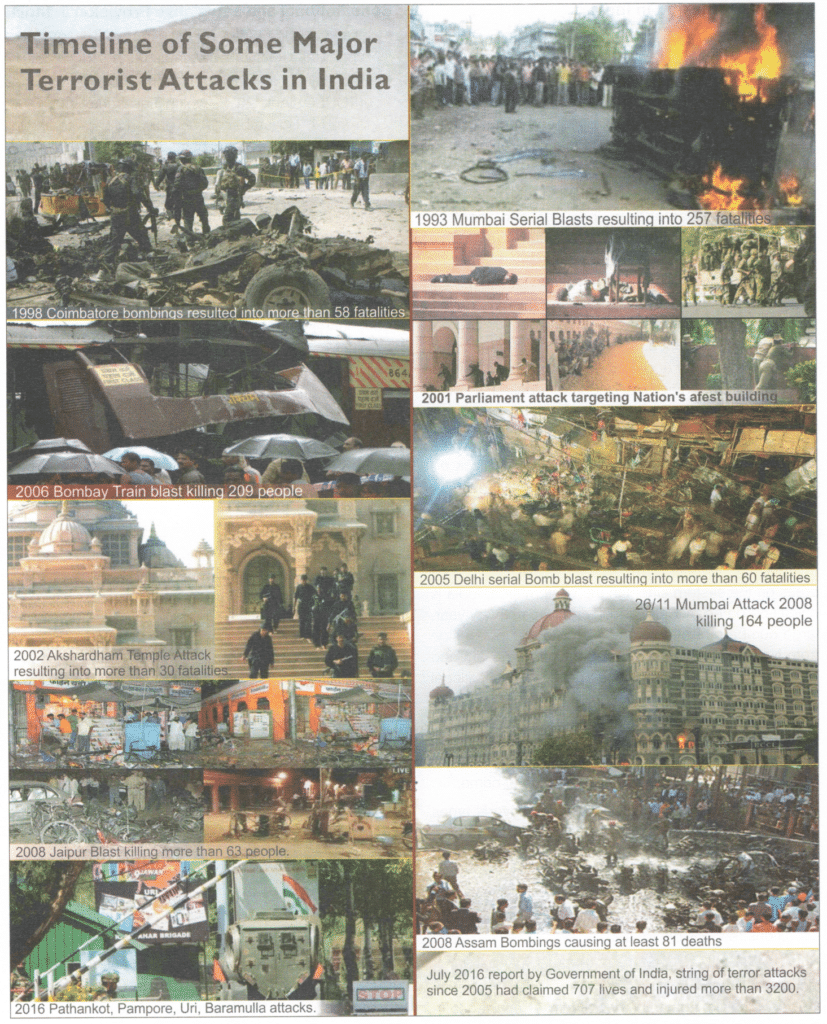
Human Trafficking Cartels
Human trafficking is the trade of transporting, recruiting, transferring, harbouring or receiving a person through the use of force, coercion or other means for the purpose of exploiting them. It is a form of modern slavery where humans are traded for the purpose of sexual slavery, forced labour or commercial sexual exploitation for the trafficker or others.
Human trafficking is a risk to the right to life, liberty and security of person, as victims face physical and psychological violence, are kept against will, being held in slavery and servitude, being subject to torture cruel, inhuman or degrading treatment, etc. The outcome is a regime of actual and psychological imprisonment and torture.
Every year thousands of men, women and children fall into the hands of traffickers in their own countries and abroad. An estimated 700,000 to 4 million people around the world are being trafficked for labour and sexual exploitation each year. Human trafficking is the fastest-growing source of profit for organized crime. Trafficking is a lucrative industry. It has been identified as the fastest growing criminal industry in the world. It is second only to drug trafficking as the most profitable illegal industry in the world.
Types of Trafficking
Debt Bondage:
- Victims of human trafficking are not permitted to leave upon arrival at their destination. They are held against their will through acts of coercion and forced to work or provide services to the trafficker or others. The work or services may include anything from bonded or forced labour to commercialized sexual exploitation. The arrangement may be structured as a work contract, but with no or low payment or on terms which are highly exploitative. Sometimes the arrangement is structured as debt bondage, with the victim not being permitted or able to pay off the debt.
Sex Trafficking:
- Victims of Sex trafficking are generally found in dire circumstances and they are easily targeted by traffickers. Individuals vulnerable to traffickers include homeless individuals, runaway teens, displaced homemakers, refugees, and drug addicts. While it may seem like trafficked people are the most vulnerable and powerless minorities in a region, victims are consistently exploited from any ethnic and social background.
Child Trafficking:
- Many childrens are forced into child trafficking illegally to serve in the form of bonded labour and sexual exploitation. The International Labour Organization estimates worldwide that there are 246 million exploited children aged between 5 and 17 are involved in debt bondage, forced recruitment for armed conflict, prostitution, pornography , illegal drug trade, illegal arms trade, and other illicit activities around the world.
- As they are vulnerable, children are lured, sold, or kidnapped for the purpose of sexual exploitation in hotels, night clubs, brothels, massage parlors, private residences, on sex tours etc. Sex trafficking has devastating consequences for minors, including longlasting physical and psychological trauma, disease (including HIV/AIDS), drug addiction, unwanted pregnancy, malnutrition, social ostracism, and sometimes death.
Involuntary Domestic Servitude:
- Involuntary servitude happens when a domestic worker is forced to do work in an exploitative situation as they are unable to escape. Typically in private homes, the individual is forced to work for little or no pay while confined to the boundaries of their employer’s property. This isolation keeps them from communicating with family or any other type of support network, increasing the subjection to psychological, physical and sexual abuse.
Issue of Trafficking in India
Human trafficking industry in India is multidimensional and has certain ‘supply’ and ‘demand’ factors. The ‘supply’ factors include-poverty, child marriage and non-preference for a girl child among others. The ‘demand’ factors include migration (International and intra-national), marriages in states with low sex ratio among others. Victims of forced prostitution are often subjected to psychological and/or physical torture (threats, humiliation and degradation, beatings and rape) by their traffickers. When forced to return home, the victims are faced with disappointment from their families and friends, having fallen short of everyone’s expectations to make a new start. Many a times, victims are regarded as offenders and accomplices instead of victims of crime. Hence, they are accused of offences such as illegal entry and stay, illicit employment, illegal prostitution, impermissible begging, dealing in illicit drugs, and other petty crimes.
- Reasons for the lack of prosecution and convictions are the underground nature of the crime, the lack of testifying victims be it due to fear or due to the fact that many victims are even detained/deported as illegal immigrants/criminals and the lack of adequate antitrafficking legislation.
In India, human trafficking is rampant across the border areas on the eastern side. On the eastern side, India is chiefly bordered by Bangladesh and Nepal. Every year, large numbers of people cross over to the Indian side from Nepal and Bangladesh. Uttarakhand, Assam and Meghalaya act as the chief entry points for these illegal immigration. The illegal immigration overlaps human trafficking in some cases, especially in the case of women, since women, sometimes, are forcibly pushed across the border. These people often suffer from abject poverty which forces them to take the path of crime.
Prevention of human trafficking requires several types of interventions. Prevention as a strategy to combat trafficking has to focus on areas of sensitization and awareness among the public, especially those vulnerable pockets of trafficking at source areas as well as convergence of development services to forestall conditions responsible for it.
Human trafficking is indeed a modern form of slavery. It includes the most inhuman of practices which go against the very ideals of right to human dignity as envisaged in the UN charter. It is also seen as a threat to the security and integrity of a country. Every measure must be taken along the lines of a multi-sectoral approach by successive governments to wipe out this menace.
Constitutional and Legislative Provision in India
- Trafficking in Human Beings or Persons is prohibited under the Constitution of India under Article 23(1).
- Protection of Children from Sexual offences (POCSO) Act, 2012, which has come into effect from 14th November, 2012 is a special law to protect children from sexual abuse and exploitation.
- The Immoral Traffic (Prevention) Act, 1956 (ITPA) is the premier legislation for prevention of trafficking for commercial sexual exploitation.
- Criminal Law (amendment) Act 2013 has come into force wherein Section 370 of the Indian Penal Code has been substituted with Section 370 and 370A IPC which provide for comprehensive measures to counter the menace of human trafficking.
- There are other specific legislations enacted relating to trafficking in women and children:
- Prohibition of Child Marriage Act, 2006
- Bonded Labour System (Abolition) Act, 1976
- Child Labour (Prohibition and Regulation) Amendment Act, 2016
- Transplantation of Human Organs Act, 1994
- Specific Sections in the IPC
- State Governments have also enacted specific legislations to deal with the issue, (e.g. The Punjab Prevention of Human Smuggling Act, 2012).
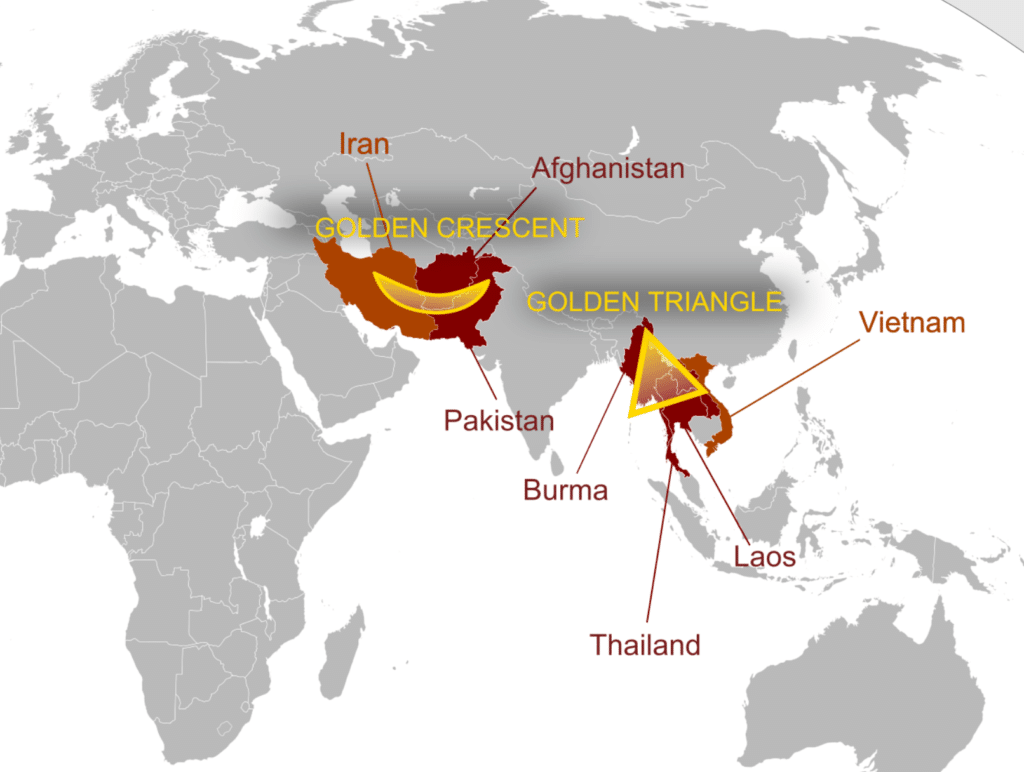
Drug Cartels
India is wedged between the Golden Crescent, which is India’s main centre of illicit Opium production in Afghanistan, Iran and Pakistan and the Golden Triangle three countries of Southeast Asia: Myanmar, Laos and Thailand. The proximity has traditionally been viewed as a source of vulnerability, since it has made India both a destination and a transit route for opiates produced in these regions. Along with it, various psychotropic and pharmaceutical preparations done domestically add to the menace. The illegal flow of drugs not only violates India’s sovereignty but is also perceived as a significant threat to national security.
Routes Used
Trafficking of drugs takes place overwhelmingly through land borders followed by sea and air routes.
- Nearly 70% of narcotics and drugs are trafficked over land using various modes of transportation making the country’s borders, the first point of contact for drug trafficking. They are trafficked through India Nepal border, India-Bhutan, IndiaMyanmar and India-Bangladesh.
- Heightened vigil along the land border has made the drug traffickers to shift the route from land to sea. Suspicious boat movements, occasional seizures and several confrontations reaffirm the suspicion of intelligence agencies about the massive flow of drugs from Afghanistan to India through Indian Ocean.
- Moreover, Border fencing has forced the traffickers towards sea as an alternate route. Heroin is being smuggled into Rann of Kutch from Karachi in various country made boats.
- Trains have also been in use to transport drugs. The Samjhauta Express has alleged to have become a major carrier of illicit drugs from across the border
- Closing of the traditional Balkan route via Iran during the Iran-lraq war led to rerouting of drugs to India. The border is witnessing increase in trafficking through this particular route since 1983 which can be surmised from the quantity of heroin seized by various law enforcement agencies.
- Heroin and hash produced are trafficked into the country through the border states of Gujarat, Rajasthan, Punjab and Jammu and Kashmir. The most preferred route during the 80s has been Thar Desert because of it being a traditional route. Also, being barren, it is poorly guarded and it provided enough hideout for illicit drugs.
- Major as well as secondary airports in the country are used by traffickers to smuggle drugs through personal carriers, postal services etc.
Impact of Drug Cartels on India
- One of the biggest consequences of drug cartels is that it opens a path for illegal profits from the black markets. It thus becomes a threat to national security, sovereignty, and law and order situation of the country.
- The growing linkage between drugs, arms and insurgency gets inculcated due to their dependence on each other. For example: insurgents sourcing funds from drug trafficking in order to procure weapons they need to fight the government.
- Exploitation of the trafficking routes by terrorists with the help of well entrenched criminal networks to infiltrate with arms and explosives adds a critical dimension to the security of borders. It is estimated that around 15% of the finances of the Jammu and Kashmir militants were generated through the sale of drugs.
- In North East, smaller insurgents groups are involved in drug trafficking to generate quick funds. Breach of the international borders by the drug traffickers implies that the same routes could be used for the smuggling in weapons as well as terrorists into the country. For example: Investigation into the Pathankot attack, that took place on 31st December 2015, hinted terrorists entered into India from Pakistan through the routes tried and tested by drug traffickers.
- Easy supply of narcotics and drugs to domestic population produces dysfunctional behavior thereby creating law and order problems in the society. Also, it leads to huge economic drain on the country through loss of production and diversion of resources for caring and rehabilitation of drug addicts.
- In addition to economic loss, people, especially youths, suffer from mental trauma due to intake of drugs like in Punjab where an entire generation seems to be under the grip of debilitating addiction.
India’s Response
The trends and patterns of narcotics and drug consumption over the years have shown significant shifts, the share of opium use among addicts has decreased while the share of heroin, cannabis and other psychotropic drugs have increased. India has adopted a comprehensive approach of reducing supply as well as demand for narcotics and drugs. The approach comprises of:
- Enacting legislation like Narcotics Drugs and Psychotropic Substances Act, 1985. The Act provides for rigorous punishment for any person violating the act. Along with it Government has also enacted Prevention of Illicit Trafficking in Narcotics Drug and Psychotropic Substances Act, 1988, few section of Customs Act are implemented for curbing the illicit export of precursor chemicals.
- Bilateral agreements were signed with Afghanistan (1990), Bangladesh (2006), Bhutan (2009), Myanmar (1993) and Pakistan (2011).These agreements have been instrumental in establishing mechanism for mutual exchange of information, of operational and technical experience, cooperation for joint investigations and other assistance. India is also a signatory to the SAARC convention on Narcotics Drugs and Psychotropic Substances, 1993.
- Since mid-1980s, India started building fences across the India-Pakistan border and strengthened surveillance along the border. This has helped in reducing the illicit flow of drugs from across the border which can be corroborated by the reduced seizure figures as well as the increased use of sea routes.
- Number of voluntary organizations are involved with the government running various de-addiction and rehabilitation centres.
- Several coastal police stations have been established and were provided with interceptor boats and other vehicles to intensify vigilance along the coasts and seas.
Conclusion
Despite various measures, prevention of drug trafficking has not been able to achieve much success due to lack of priority accorded to prevention of drug trafficking. Turf war between various agencies, pervasive corruption, intelligence failure, poor drug detection training and lack of technology hamper drug prevention efforts in the country. As drug trafficking has serious ramification over country’s security, it is time for India to pay more attention to the problem and formulate robust measures to overcome the loopholes in its strategy of preventing drug trafficking.
Also, special training to the local forces of the Border States should be provided to make sure that they are able to detect and take preventive measures in time. Along with it, corruption should be eliminated through better use of technology.
MoU between India and Nepal on Drug Demand Reduction
The Union Cabinet has given its approval for signing of a Memorandum of Understanding (MoU) between India and Nepal on Drug Demand Reduction and Prevention of Illicit Trafficking in Narcotic Drugs and Psychotropic Substances and precursor chemicals and related matters.
The MoU lists out the areas of cooperation on drug matters between the two countries. It also indicates the mechanism of information exchange and the competent authorities in the two countries who are responsible for the implementation of the MoU and exchange of any information.
Colombo declaration to Counter Drug Trafficking
The Colombo Declaration (2016) seeks to coordinate anti-drug efforts in the Indian Ocean Region. The declaration was adopted at the High-Level Meeting of Interior Ministers of Indian Ocean Region (IOR) to Counter Drug Trafficking. As the narcotic drug trafficking in the Indian Ocean Region poses a great threat to the security and peace in the region as well as considering the link of drug trafficking to funding of terrorism and organised crime, it was resolved by the 18 littoral states of the Indian Ocean Region to work towards making the region a “Drug Free Zone”.
The declaration emphasizes the need for the cooperation amongst the coastal areas, more closely in order to share information in narcotic drug trafficking, provide mutual legal assistance and enforce the maritime law. The declaration calls on the littoral states of the Indian Ocean Region to hold meetings on a yearly basis within the framework of the Southern Route Partnership (SRP) of Indian Ocean Forum on Maritime Crime (IOFMC). These states need to assess and share reports on the threat of drug trafficking in the IOR , which would in turn help in developing a coordinated approach for countering such threats.
Trade Wars
A trade war is a situation in which two countries try on to damage each other’s trade through implication of quotas and restrictions. It is a result of protectionism in which countries retaliate against a country that imposes trade barriers such as tariffs and quotas. It has the potential to affect the economic stability of the country as it would directly affect exports and imports thus creating inflationary pressures. Moreover, this could lead to a string of tit-for-tat responses that escalate global tensions.
For Example: There is often talk of India going on trade war with China as was implied during Doklam standoff when India imposed anti-dumping duties on several Chinese products . A trade war with China could affect the relationship between India and China. As the two countries have a not-so-friendly relation, tensions created due to trade war may further precipitate into a full war. This would create a security problem. Also, India would be affected badly in various sectors if it starts a trade war with China. For example, power sector, telecom sector, etc. Thus, not only exports are going to be affected badly but also the imports which are crucial at this stage.
Fake Currency Rackets
Counterfeit currency refers to an imitation currency that is produced with an aim to deceive. The act of producing fake notes amount to forgery or fraud, as it is done without any kind of legal sanction. Currency counterfeiting is a crime that continuously poses a threat to the country’s economy and is a source of financial loss to its citizens.
The counterfeit Indian currency printed in Pakistan is moved to Bangladesh and Nepal either directly or through Dubai, according to various intelligence reports. These counterfeit currencies are then brought across the porous India-Bangladesh and India-Nepal border. The multiplicity of routes, ready market and thin presence of law enforcement agencies across the border of Nepal and Bangladesh allow the movement of fake currencies.
The government went for demonetizing the Rs. 500 and Rs. 1000 notes to make the fake currency useless as fake currency is widely used to finance terrorism. According to the RBI annual report, the circulation of Fake India currency note came down. It reduced to 522,783 in 2017-18 from 762,072 in 2016-17.
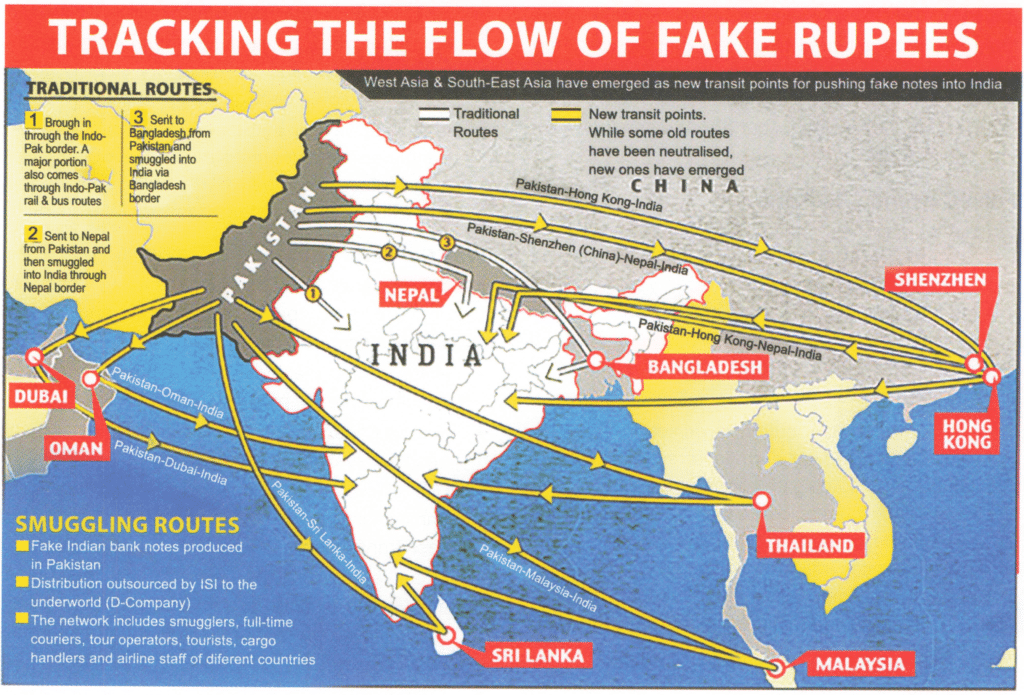
Threats
- Counterfeit currency helps in the narcotic production and distribution which compounds the problem of drugs.
- Fake notes are used for financing of various terrorist activities on Indian soil, thus leading to organized crime.
- Circulation of counterfeit currency can destabilize the economy as more circulation can inflate the prices of necessary goods.
India’s Response
- One of the objectives of Demonetization was to sweep away the counterfeit currency in circulation of 500 and 1000 denominations. The introduction of new security features in new notes of 500 and 2000 was a step in the same direction. This would increase the cost to print fake currency and thus reducing the profit and incentive to produce fake currency.
- India amended the Unlawful Activities Prevention Act under which possession of fake notes with the intention to damage the monetary stability of the country would be considered as an act of terror.
- India has signed agreements with countries like Bangladesh and Nepal in order to prevent smuggling of fake notes. Also, India has been working towards
- India amended the Unlawful Activities Prevention Act under which possession of fake notes with the intention to damage the monetary stability of the country would be considered as an act of terror.
- India has signed agreements with countries like Bangladesh and Nepal in order to prevent smuggling of fake notes. Also, India has been working towards improving the border management of the country.
Way Forward
- The Reserve Bank of India needs to constantly upgrade both paper-based and print based security features of Indian currency.
- Notes sorting machines should be installed at all bank branches to promptly detect fake notes.
- It is important to create awareness among the people on various ways to identify fake notes.
- Use of credit card/debit card and online/digital transactions needs to be encouraged instead of cash transaction.
- Effective cooperation among the concerned agencies is essential to address the threat. Holistic approach along with real-time input sharing is needed.
- External dependence on security paper and ink should be reduced by increasing indigenous production.
Given the multidimensional aspect of the fake currency notes, the problem needs to be dealt in a holistic manner. Various agencies need to work together to curb the menace of fake currency.
Cyber Attacks
Cybercrime, that is, offences against and by means of computer systems – has been around for more than three decades. However, with the rapid evolution of the information society and its dependence on information and communications technologies (ICT), the vulnerability of societies to cybercrime has increased considerably.
Governments all over the world are struggling with the increasing levels of cybercrime and associated complexities of securing electronic evidence (e-evidence) of any type of crime or economic offence. Cyber Security includes all technical processes and practices designed to protect networks, computers and data from attack by unauthorized users. Cyber security is necessary to ensure national security, economic security, and business security and to reduce illegal activities like phishing, hacking, blackmailing, etc.
Reasons for Complexity of Cyber Security
- No cyber security program can be totally full proof because of constant emergence of new technology.
- Even when threats are known, enemy is unseen. Therefore, continuous upgradation of security system is needed.
- Changing nature of security risks itself.
Cyber Attacks in India
According to a study by ASSOCHAM, there has been a surge of about 350% in cybercrime in India from the year 2011 to 2014. Symantec ranked India 3rd most targeted country in terms of cyber attacks in 2017. According to a report by CERT-ln (Computer Emergency Response Team-lndia) there have been more than 53,081 cyber security threat incidents in 2017. Some of the major cyber security incident in last one year:
- Wannacry: Ransome Wannacry swept the world in May, 2017 as it targeted computers running the Microsoft Windows operating system. It was reported to hit some banks in India and some businesses in Tamil Nadu and Gujarat among others.
- Petya: India was also on the top 10 list of countries to be hit by Petya ransomware attacks. Petya, first discovered in 2016, infected the Microsoft operating system.
- Data Breaches: In May, Zomato stated that it was affected by a data breach which led to details of 7.7 million users being stolen. The leaked information was listed for sale on a Darknet market. Many other incidents like website hacking and data stealing from a server have taken place. Online credit card scams prevalent in present times also involves the same .
Securing a cyberspace is a difficult task as architecture of internet is to promote connectivity and not security. Cyber criminals have an inherent advantage of deciding the time and place of attack. There is a need for robust policy environment with adequate technical support. Businesses should not limit their effort towards cyber resilience for compliance. They must practice self regulation. Also, there should be more awareness and participation of citizens to mitigate the risk. Establishment of multidimensional public-private collaborations between law enforcement agencies, the information technology industry, information security organizations, and other stakeholders could also be looked upon. Moreover, India needs to consider acceding to Budapest Convention on cybersecurity.

Maoists and Naxalites
Naxalism originated in the rural parts of eastern India and the term derives its name from a village called the Naxalbari in the state of West Bengal. Naxals are considered far left radical communists who support Maoist political ideology. Its spread is seen to be in less developed areas of rural central and eastern India such as Chhattisgarh, Jharkhand, Odisha, Andhra Pradesh etc.
Maoism originated in China as a form of communist theory derived from the teachings of the Chinese political leader Mao Zedong. It emphasized upon the people’s social and economic life by establishing a classless society through an armed revolution. ‘Naxalism is based on the principles of Maoism to achieve a similar transformation in India.
Factors Responsible for the Growth of Naxalism
Naxalism is the outcome of a number of factors related to political, social and economic in nature:
- The movement was influenced with the political ideology of Chinese Communist Party and Mao Zedong. The insensitive nature and apathy of the Political system towards tribals remained one of the main factors that led to the uprisings. The inability of the legitimate political authority to provide avenues for structural uplift to the deprived sections of the society is the main reason.
- Problems of poverty, economic inequality and underdevelopment became the hotspot for naxalism. Entry of mining companies in tribal lands and forests posed threat to the livelihood of the tribals which motivated many towards Naxalism.
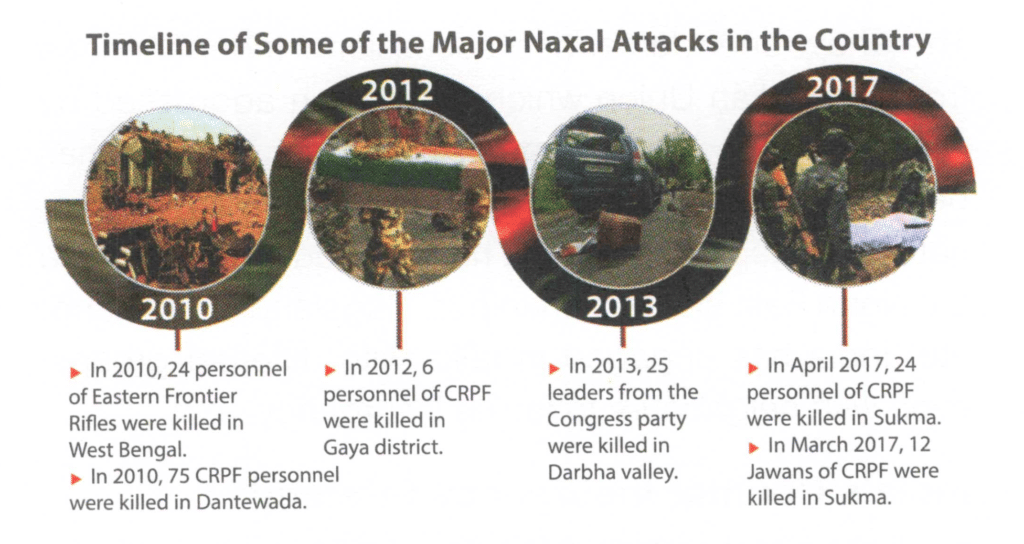
Government Respone to Naxalism
Government has adopted various measures to tackle the growing menace of Naxalism in the country.
- Deployment of Cobra battalions, CRPF, Modernization of Police Force Scheme etc.
- Intelligence sharing, interstate coordination and Unified commands.
- Assistance in development works, various development programmes, Civil Action Plans and surrender policies of state governments to bring back naxals into mainstream society.
- Saranda Action Plan under which a rural livelihood development plan is made for the naxal hit areas of underdeveloped Saranda region in Jharkhand.
- The Government has launched a scheme named as ‘SAMADFIAN’ – with ‘S’ for Smart leadership; ‘A ’ for Aggressive Strategy; ‘M’ for motivation and training; ‘A’ for actionable intelligence; ‘D’ for dashboard based KPIs (key performance indicators) and KRAs (key result areas); ‘FI’ for harnessing technology; ‘A’ for Action plan for each theatre and ‘N’ for no access to financing to tackle naxalism.
There is a problem of coordination between various agencies involved in the prevention of the naxalite movement. Increased and improved coordination between various agencies, more development works in the Naxal hit regions and the use of technology could provide a solution to the problem.
Insurgents and Cross Border Ethnic Groups
In case of India, it can be seen as an armed rebellion and violent protests against the government. Threats to India’s integrity and internal security has existed in the form of rebellion in Punjab, militancy in Jammu and Kashmir, insurgency in the North East and Left wing extremism in the central part.
There have been demands of secession or Independence from the Indian Union which have been addressed by wearing down the insurgents until the demand has been dropped or modified. To accommodate ethno-nationalist aspirations, India has created new states like the North East states of Manipur, Nagaland, Jharkhand, etc. India has engaged in talks with different groups, even with neighbours to tackle insurgency.
India’s Counter Insurgency Strategy
- Restrained use of heavy artillery against the insurgents. It has even involved itself in talks with various insurgent groups like in the North East (Nationalist Socialist council of Nagaland-IM).
- Agreements with countries neighbouring like Myanmar, Bangladesh, and Bhutan to prevent insurgency. India even conducted counterinsurgency operations in countries like Bhutan, Myanmar. Pressure from India has led to arrests and deportation of many insurgents and their leaders from Bangladesh.
- Improving the border management, use of advanced technology and physical guarding of borders. India is planning to fence the Myanmar border and complete the fencing of India-Bangladesh border.
- India has displayed a high degree of political flexibility and has adopted a policy of rehabilitation of insurgents and involved many groups into the democratic process and many have even fought election. This has helped in toning down the demands of insurgents from secession towards development issue in the North East.
- Wherever necessary it has used hard power such as Operation Bajrang, Operation Rhino to put down the violent activities of ULFA. Even against the Bodo militant groups it opted for Operation All Clear. The military response to insurgency has been to prevent, protect & preserve infiltration, isolate and then attack and finish.
The problems of insurgency and cross border ethnic groups require a holistic approach. It requires development of the North East region along with Act East Policy. Need to improve the border management and improve livelihood opportunities along the border and in the region.
Illegal Immigrants
Unlike refugees, illegal migrant is a person who crosses an international boundary without any valid document. According to a report by the Ministry of Home Affairs, there are more than 2 crores illegal immigrants in India from Bangladesh. Most of the illegal immigrants have taken shelter in the state of Haryana, Jammu, Hyderabad, Uttar Pradesh and Delhi. There has been large populace of illegal migrants from Bangladesh to Assam.
Consequences of Illegal Migration
- Social: The silent and invidious demographic invasion of Assam is already changing the demography and increasing community tension in the region.
- Economic: It creates financial burden on the state as providing basic amenities become a challenge. Moreover, it displaces the native workers thus decreasing the wage level with increasing population.
- Political: It leads to issues like illegal voters who, due to their population, act as a vote bank which affects the political will of any government to take action against them. Similarly, Assam agitation which led to government instability caused the problem of law and order.
- Security: Pakistan’s ISI has been active in Bangladesh supporting the militant movements in Assam. Among the illegal immigrants are also militants who carry terrorist activities affecting the state’s security.
Government Response
- A National Register of Citizens is being prepared in Assam to identify the illegal immigrants in the state. The final draft of the updated National Register of Citizens (NRC) in Assam listed 2.89 crore citizens. These were out of 3.29 crore applicants for inclusion.
- Increasing vigil at the borders through better monitoring techniques and improving the border management especially at the India-Bangladesh border to check illegal migration.
- Centre has directed the state governments to set up a task force at district level to identify and deport illegally staying foreign nationals.
Way Forward
- The central government should appoint a National Immigration Commission to frame a National Migration Policy and National Refugee policy. Moreover, it needs to strengthen Foreigners Act and prevent counterfeiting of documents through technology and use of better prevention methods.
- Border fencing must be completed on a war footing along the India-Bangladesh border and the existing Border security force needs to be increased and strengthened.
- The ongoing National Register of Citizens exercise needs to be completed and finished on time and the illegal immigrants should be deported.
- The illegal migrants’ determination by tribunal needs to be repealed and a nodal authority needs to be created to be able to coordinate with the intelligence reports.
- The problem of illegal immigrants needs to be solved multi-dimensionally and at a faster pace as they are turning into a security threat.
Transnational and Multi-National Corporations
Multinational Companies are mostly consumer goods manufacturers having investment in other countries. However, they don’t have coordinated product offerings in each country while Transnational corporations are much more complex having a central corporate facility who give decision making, Research & Development and marketing powers to each individual foreign market. Both of them are highly influential to globalization, economic and environment lobbying in most countries.
These corporations run the economy of any country as can be seen in the case of India. Having a number of MNCs has its own advantages as, along with the necessary revenue, they provide employment opportunities, bring advanced technologies, establish Research and Development facilities in the country. However, they are also considered to be a threat. The reasons being:
- Economic: Many companies are involved in tax avoidance which leads to loss of tax revenue to the government. Moreover, they lobby the government to reduce taxes. The cost of reduced revenue falls on the common man which further leads to increase in taxes of regular items. Also, if this continues, these companies try to monopolize the market thus threatening the existence of small firms.
- Social: They have brought a culture of homogenization leading to conflict and creating law and order problems. Thus, it leads to threat to internal security .
- Environmental: They are more concerned with profit and thus disregard environment leading to further degradation, thus creating threat to local population. Example, pharmaceutical companies. It can, at times, create a disaster as experienced in Bhopal Gas Tragedy (1984) where a number of people died, in addition to many in the coming generation who were affected.
Way Forward
There needs to be adequate safeguards to prevent them from becoming a threat. Some of the steps are as under:
- India should look towards enacting new legislations to safeguard India’s interest. Also, we must strive towards effective implementation of the existing provisions like environmental impact assessment, corporate law, in addition to strengthening acts like Whistle Blower Act among others.
- There is need for partnership with other countries and their agencies involved in the prevention of tax avoidance.
- A clear and well laid policy, transparency in the functioning of the corporation should be promoted to neutralize any threat emanating from it.
Sea Piracy
Acts of piracy threatens maritime security by endangering, in particular, the welfare of seafarers and the security of navigation and commerce. These criminal acts may result in the loss of life, physical harm or hostage-taking of seafarers, significant disruptions to commerce and navigation, financial losses to ship owners, increased insurance premiums and security costs, increased costs to consumers and producers, and damage to the marine environment. Pirate attacks can have widespread ramifications, including preventing humanitarian assistance and increasing the costs of future shipments to the affected areas.
The 1982 United Nations Convention on the Law of the Sea (UNCLOS) provides the framework for the repression of piracy under international law. While the international border clearly defines the territorial limits and sovereignty of a country over its territory, the maritime boundary delineates the limits of the maritime zones between the adjacent nations subject to internationally recognized rights of innocent passage and freedom upon the high seas, in accordance with the United Nations Conference on the Law of Sea.
- Gulf of Aden has been a hot bed for Somali pirates for quite some time. According to a rough estimate, piracy is now a whopping billion dollar global business in the region.
Due to reports of rising incidents of piracy, surveillance has been increased in Indian Ocean Region. Indian Navy carries joint patrolling of Exclusive Economic Zone (EEZ) of Maldives, Seychelles and Mauritius.
Measures Taken by Government:
The Government has taken the following steps as part of various preventive/mitigating security measures to deal with sea-piracy:
- An Inter-Ministerial Group (IMG) has been set up by the Government under the Ministry of Shipping to deal with the hostage situation arising out of hijacking of merchant vessels with Indian crew at sea. Government had also approved the Contingency Plan for dealing with piracy and hijacking of merchant ships and constituted a Committee of Secretaries on Anti-Piracy and Hijacking at sea (COSAPH) under the Chairmanship of Cabinet Secretary.
- With the revision of the Piracy High Risk Area (HRA), some of India’s maritime security concerns viz. floating armouries and proliferation of private security are likely to be addressed. In addition, Indian ship-owners are likely to benefit significantly on account of savings on insurance and associated operating costs.
Conclusion
India remains committed to ensuring freedom of navigation in the global commons and strengthening maritime security in the region especially in the East Arabian Sea. Towards this, Indian Naval ships and aircraft continue to escort merchant ships of all nations in the Gulf of Aden.
Bookies and Cricket Mafias
Bookies are often well-connected people, who get in touch with players through mutual friends, acquaintances or business associates. Once they become close enough to the players to call them, they talk to them anytime, anywhere in the world and start making calls of different bets and decide the rates for the betting market. The level of interaction and influence depends on the person involved and where he wants to take the business. A 13 member cricket betting gang was arrested on December 2017 which had link with some neighbouring states and some foreign countries. The foreign bookies have handlers in the country who are running the racket as was confessed by the arrest of Puma Chandra Rao who was involved with the cricket betting mafia since long.
A report by Central Bureau of Investigation in 2010 claimed that underworld mafia has been involved in the cricket betting which was also substantiated from reports of Mudgal Committee and Lodha Committee. India-South Africa series (1999-2000) was fixed and a number of players were caught in the fixing saga. A similar incident also came up when few IPL players were caught fixing in the IPL which led to the Lodha reforms.
Threat
Apart from being a threat and challenge to the game of cricket, there are other repercussions. Some of them are as under:
- It is a threat to the internal security.
- It threatens the player’s life and the dignity and integrity of the game.
- Money gained from fixing is used by underworld Mafias for financing illegal and anti-state activities. The involvement of Dawood Ibrahim, Chhota Shakeel is well documented who have been using the money for their drug activities, fake currency rackets and other activities.
Way Forward
There have been recommendations from Mudgal committee as well as Lodha committee which went on to suggest various measures. Some of them have been stated below:
- Need to continuously upgrade the technology and train the security agencies to be able to nab the bookies.
- International Cricket Council (ICC) needs to be more proactive and adopt certain preventive measures to prevent such activities.
- Need to legalize betting.
International Antiquities Smuggling Rackets
India is bestowed with rich cultural heritage due to which it possesses plenty of civilizational antiquities. Due to legal loopholes and other administrative flaws, trade in such antiquities has disturbed the civilizational heritage. Moreover, illegal trade in paintings, sculptures, and other artifacts are considered to be one of the world’s most lucrative criminal enterprises.
According to Global Financial Integrity, a Washington based advocacy group, such trade is estimated to be more than $6 billion a year. Due to poor implementation of antiquities protection laws and bureaucratic laziness, traders find a fertile ground to plunder past heritage objects and make a jackpot worth billions by selling these antiquities globally. Despite the existence of The Antiquities and Art Treasures Act, 1972 whose aim is to protect antiquities, the plunder continues unabatedly.
- The stolen objects can never be redesigned or remodeled making them irreplaceable. Moreover, it makes us lose crucial historic information regarding the era of object.
Legal Provisions
- Antiquities and Art Treasures Act 1972
- Indian Treasure Trove Act (Tamil Nadu Amendment) 1949
Executive Policies
- Bilateral agreements to recover smuggled artefacts
- National Mission on Monuments and Antiquities
- National Manuscript Mission for Documenting Heritage
Reasons of India’s Poor Performance in Preservation of its Antiquities
- Lack of Dedicated Database: India does not have a dedicated inventory of its cultural objects, preserved or lost. We must maintain a record of objects that uphold a cultural importance which will make it easy to track, in cases when they go missing.
- Lack of Investigating Wing: The time is ripe to create an exclusive wing for investigations of cases involving loss of antiquities. Presently, these cases are dealt by CBI which doesn’t have any specialized experience and understanding of the issue. The time is ripe to create an exclusive wing for the same.
- Lack of Proper Laws: Though we have laws regarding the same, but these don’t fulfill the present day needs as they were framed in 1972 when the technology was almost non-existent. With time, we need to improve preservation strategies through better legislative actions.
- Political Unwillingness: Political apathy and bureaucratic insensitivity towards the issue is another problem. Though a few states have taken initiative to maintain Special Forces for preservation, but they too are understaffed and unqualified missing proper training and knowledge about the international laws. Thus, centre needs to step in and come up with strategies to prevent such illegal activities in future.
- Barriers to Good Samaritans: Person who dutifully reports the lost object is often made to go through cumbersome procedure which forces common man to not report such issues, even if they get some information.
Way Forward
- A dedicated Database to keep a track of present and lost artifacts should be created.
- Community Participation: Steps must be taken to encourage more participation from people in order to reduce theft of artifacts. Environment should be created to report any information about lost artifacts as local communities get first-hand information regarding any such findings. For example, recent Rakhigarhi Excavation was first reported on Farming land by local workers and farmers.
- Dedicated Policing: India should learn from international best practices like dedicated policing done in some European countries. India can make some laws with a few Indian modifications to suit its need.
- Mission Mode Recovery: India must be proactive to recover its lost artifacts. It should check catalogues at international auction houses, posting news of theft on websites and should post about theft in the International Art Loss Register by sending photographs of stolen objects electronically to dealers and auction houses to increase the chances of quick recovery.
- Incentives to Informers: The provision of substantial incentives could force individuals to come up and report information about lost artifacts.

Thankyouuuuuuuuuuuu